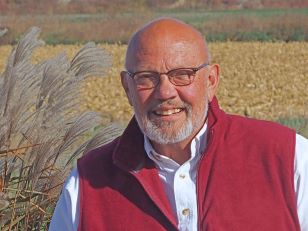
There were littler ones, babies even, hard as that is to consider. It looks to me as if the lineup in this proud old photo is just the school age kids. There’s a little guy in white in the front row, but the rest, even from a distance, look like middle schoolers with some high schoolers thrown in. At its height, 175 kids called the Norwegian Lutheran Children’s Home, in Beloit, Iowa, their home, their only home.
The 50th Anniversary booklet of the Beloit Children’s Home includes a shot that’s hard to look at, but have a look. There were little ones too. In a way, I suppose, all the kids were little ones.

Never heard of Beloit, Iowa? You’re not alone. Once it was a booming little burg on the banks of Big Sioux River, just a couple miles from Canton, SD, less than an hour away from where we live. Once upon a time there was an academy here too, but that place–a kind of high school/seminary–eventually moved up river to Canton when a more spacious building could be had. A Norwegian immigrant young man named Rolvaag went to school there, graduated in 1901, and went on to write a tale of the region’s story, Giants in the Earth. Maybe you’ve read it.
Then again, once upon a time, that very school, then called Augustana Academy, moved once more down the road and up the river to Sioux Falls, where it became Augustana College, and is now Augustana University. Started right there in Beloit, a town that mostly isn’t there anymore. Population? –maybe fifty in a storm, probably less if the Big Sioux is flooding.

The Children’s Home is long gone. About the only reminder is a big square, three-storied farm house that once upon a time was the orphanage school. Yet a few years ago, a cupola stood in the front yard, a remnant, I believe, the peak above the admin building. Gone now.
There’s a water tower out back that dates from the old days, and maybe a couple of sheds that hearken to a long-ago and otherwise unrecognizable past. More than 75 years have passed since the place was home for orphans from the region. It closed its doors in 1945.
In fact, whether or not it was an orphanage, per se, could be debated. In all likelihood, most of the kids weren’t orphans at all.
“Mother was sick most of her life. She had Tuberculosis,” one of the kids wrote long, long ago. “We moved a lot trying to find a dry climate for her. The last place we lived was near Mason City. Mother became so bad she was bedridden.”
The girl’s story is probably much the same as the stories of most others, and there’s more: “I’ll never forget the last time we saw her, so sick; she hugged us all. We were taken to Beloit and later she died. We were, I remember, a sad and lonely four kids for some time.” Early deaths like her mother’s were not uncommon back then, but neither another loss she remembers well too: “Dad came to see us maybe three times. . .”

Orphans weren’t so much orphans as they were neglected, even forsaken children, left to bear a life’s sadness, kids simply forgotten.
A mile or so north and east, the Beloit cemetery features a stately marker that notes the deaths of some of the kids who never left Beloit, who died of one malady or another.

The history of residential schools like Beloit Children’s Home takes a beating today because few kids of the era could be as easily exploited as unwanted, unloved kids. The horrors of that abuse means almost any reference to a place like Beloit’s Children’s Home makes people cringe.
But some of those locals who walked the grounds were saints, determined to give castaways whatever volume of love they could offer, in this world and the next.
And it still exists. Even though what’s there on the grounds of the Beloit Children’s Home is not recognizable of what once was, there still is, today, a Beloit Children’s Home; but it’s changed its name and address. Look it up. Today, Beloit Children’s Home is in Ames, Iowa, where a descendent institution tries to help really tough kids find a way to make life a go.
That old, long-gone Home just off the banks of the Big Sioux, with the aid of two or three other children’s homes in the state, was the beginnings of an outfit called Lutheran Social Services. You may have heard of it. They do really good work.
You have to get a ways away from things to find the town, but if someday you choose to take note of what’s left of Beloit, Iowa, just smile as you pass through. Just remember that more than a century ago, those local folks who helped out, who showed kids how to wash dishes and milk cows during the operation of a huge orphanage that’s now, even in memories, just about completely gone, remember those people believed just as firmly in a guiding principle Lutheran Social Services still extols– “Practicing Compassion Will Change the World.
Consider this: Augustana University and Lutheran Social Services both started right here–not bad for something of a ghost town. Both institutions were born in Beloit, Iowa.
Go ahead and smile. Beloit was also–there’s no denying it–a place for dreams.

